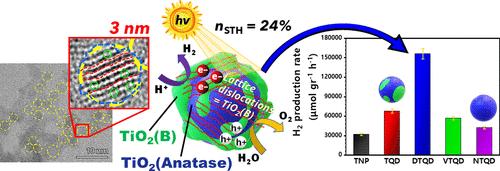{TiO2/TiO2(B)} Quantum Dot Hybrids: A Comprehensible Route toward High-Performance [>0.1 mol gr–1 h–1] Photocatalytic H2 Production from H2O
IF 11.3
1区 化学
Q1 CHEMISTRY, PHYSICAL
引用次数: 0
Abstract
Industrial-scale photocatalytic H2 production from H2O is a forward-looking aim in research and technology. To this end, understanding the key properties of TiO2 as a reference H2 production photocatalyst paves the way. Herein, we explore the TiO2 nanosize limits, in conjunction with the TiO2(B) nanophase, as a strategy to enhance the photocatalytic H2 production at >150 mmol/g/h. We present a targeted engineering realm on the synthesis of quantum dots (QDs) of TiO2 consisting of an anatase core (3 nm) interfaced with a nanometric shell of the TiO2(B) phase, synthesized through a modified flame spray pyrolysis (FSP) process. The {TiO2-anatase/TiO2(B)} core–shell QDs, with high specific surface area SSA = 360 m2/gr, achieve a milestone H2 production yield of 156 mmol/g/h and solar-to-H2 efficiency nSTH = 24.2%. We demonstrate that diligent control of the TiO2-anatase/TiO2(B) heterojunction, in tandem with lattice microstrain, are key factors that contribute to the superior H2 production, i.e., not only the high SSA of the QDs. At these quantum-size limits, the formation of lattice dislocations and interstitial Ti centers enhances photon absorption at ∼2.3 eV (540 nm), resulting in the generation of midgap states around the Fermi energy. EPR spectroscopy provides direct evidence that the photoinduced holes are preferentially localized on the TiO2(B) shell, while the photoinduced electrons accumulate on the anatase nanophase. Combined electrochemical and photocatalytic analyses demonstrate that the presence of an optimal TiO2(B) phase is significant for the photoactivity of TiO2 in all QD materials. High SSA does contribute to enhanced photocatalytic H2 production; however, its role is not the key-determinant. TiO2 lattice-dislocations in QDs provide extra DOS that can additionally assist in the photon utilization efficiency. Overall, the present work reveals a general concept, that is, at the quantum-size scale, lattice microstrain engineering and interstitial-states' formation are spontaneously facilitated by nanolattice physics. Diligent optimization of these properties offers a pathway toward high-end photocatalytic efficacy.

{TiO2/TiO2(B)}量子点混合物:从 H2O 到高性能 [>0.1 mol gr-1 h-1] 光催化 H2 生产的可理解途径
从 H2O 中进行工业规模的光催化制取 H2 是研究和技术领域的一个前瞻性目标。为此,了解作为制取 H2 参考光催化剂的 TiO2 的关键特性将为研究铺平道路。在此,我们探索了二氧化钛纳米尺寸的极限,并将其与二氧化钛(B)纳米相结合,以此作为一种策略来提高 150 毫摩尔/克/小时的光催化 H2 产率。我们提出了一个有针对性的工程领域,即通过改进的火焰喷射热解(FSP)工艺合成由锐钛矿核(3 nm)与 TiO2(B)纳米相外壳相连接的 TiO2 量子点(QDs)。{TiO2-锐钛矿/TiO2(B)}核壳QD具有高比表面积SSA = 360 m2/gr,实现了里程碑式的156 mmol/g/h的H2产量,太阳能转化为H2的效率nSTH = 24.2%。我们证明,对 TiO2-anatase/TiO2(B)异质结的严格控制以及晶格微应变是促成卓越 H2 产率的关键因素,而不仅仅是 QDs 的高 SSA。在这些量子尺寸极限下,晶格位错和间隙钛中心的形成增强了 ∼2.3 eV(540 nm)处的光子吸收,从而在费米能附近产生了中隙态。EPR 光谱提供了直接证据,证明光诱导的空穴优先定位在 TiO2(B)外壳上,而光诱导的电子则聚集在锐钛矿纳米相上。电化学和光催化综合分析表明,在所有 QD 材料中,最佳 TiO2(B)相的存在对 TiO2 的光活性都很重要。高 SSA 确实有助于提高光催化产生 H2 的能力,但它并不是决定性因素。QD 中的 TiO2 晶格位错提供了额外的 DOS,可进一步提高光子利用效率。总之,本研究揭示了一个普遍概念,即在量子尺寸尺度上,晶格微应变工程和间隙态的形成是由纳米晶格物理学自发促进的。对这些特性的精心优化为实现高端光催化功效提供了一条途径。
本文章由计算机程序翻译,如有差异,请以英文原文为准。
求助全文
约1分钟内获得全文
求助全文
来源期刊

ACS Catalysis
CHEMISTRY, PHYSICAL-
CiteScore
20.80
自引率
6.20%
发文量
1253
审稿时长
1.5 months
期刊介绍:
ACS Catalysis is an esteemed journal that publishes original research in the fields of heterogeneous catalysis, molecular catalysis, and biocatalysis. It offers broad coverage across diverse areas such as life sciences, organometallics and synthesis, photochemistry and electrochemistry, drug discovery and synthesis, materials science, environmental protection, polymer discovery and synthesis, and energy and fuels.
The scope of the journal is to showcase innovative work in various aspects of catalysis. This includes new reactions and novel synthetic approaches utilizing known catalysts, the discovery or modification of new catalysts, elucidation of catalytic mechanisms through cutting-edge investigations, practical enhancements of existing processes, as well as conceptual advances in the field. Contributions to ACS Catalysis can encompass both experimental and theoretical research focused on catalytic molecules, macromolecules, and materials that exhibit catalytic turnover.
 求助内容:
求助内容: 应助结果提醒方式:
应助结果提醒方式:


